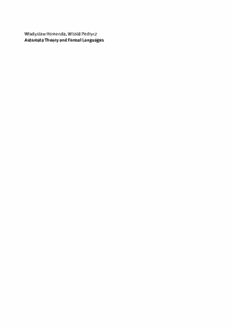
Automata Theory and Formal Languages (2022) [Homenda Pedrycz] [9783110752274] PDF
Preview Automata Theory and Formal Languages (2022) [Homenda Pedrycz] [9783110752274]
WładysławHomenda,WitoldPedrycz AutomataTheoryandFormalLanguages Also of Interest Algorithms DesignandAnalysis SushilC.Dimri,PreetiMalik,MangeyRam,2021 ISBN978-3-11-069341-6,e-ISBN(PDF)978-3-11-067669-3, e-ISBN(EPUB)978-3-11-067677-8 DeGruyterSeriesontheApplicationsofMathematicsinEngineering andInformationSciences EditedbyMangeyRam ISSN2626-5427,e-ISSN2626-5435 RoboticProcessAutomation Management,Technology,Applications EditedbyChristianCzarnecki,PeterFettke,2021 ISBN978-3-11-067668-6,e-ISBN(PDF)978-3-11-067669-3, e-ISBN(EPUB)978-3-11-067677-8 AutomationML APracticalGuide EditedbyRainerDrath,2021 ISBN978-3-11-074622-8,e-ISBN(PDF)978-3-11-074623-5, e-ISBN(EPUB)978-3-11-074659-4 Władysław Homenda, Witold Pedrycz Automata Theory and Formal Languages | Authors Prof.WładysławHomenda Prof.WitoldPedrycz WarsawUniversityofTechnology UniversityofAlberta FacultyofMathematicsand Dept.ofElectrical& InformationScience ComputerEngineering ul.Koszykowa75 ECERFBuilding 00-662Warsaw EdmontonT6R2V4 Poland Canada UniversityofInformationTechnologyand PolishAcademyofSciences Management SystemsResearchInstitute FacultyofAppliedInformationTechnology ul.Newelska6 ul.Sucharskiego2 01-447Warsaw 35-225Rzeszów Poland Poland [email protected] [email protected] ISBN978-3-11-075227-4 e-ISBN(PDF)978-3-11-075230-4 e-ISBN(EPUB)978-3-11-075231-1 LibraryofCongressControlNumber:2021947389 BibliographicinformationpublishedbytheDeutscheNationalbibliothek TheDeutscheNationalbibliothekliststhispublicationintheDeutscheNationalbibliografie; detailedbibliographicdataareavailableontheInternetathttp://dnb.dnb.de. ©2022WalterdeGruyterGmbH,Berlin/Boston Coverimage:Suebsiri/iStock/GettyImagesPlus Typesetting:VTeXUAB,Lithuania Printingandbinding:CPIbooksGmbH,Leck www.degruyter.com Foreword WhatisAutomataTheoryandwhatareitsrelationstoformallanguages?Whatcan theydo?Howdotheywork?Howcanoneusethem?ThisexcellentbookbyWładysław HomendaandWitoldPedryczprovidesthereaderasystematicentrypathintothean- swersofthosequestions.Everyefforthasbeenmadetoproduceamanuscriptthat isveryeasilyunderstood,withoutoversimplificationofthesubjectmatter.Hereisa clear,step-by-stepIntroductiontoFormalLanguagesandAutomataTheoryaddress- ingthemostimportantelementsinthefield. Toviewthedevelopmentsinthisfield,abitofpersonalhistoryisinorder.When SamLeeandIwroteourbook“FuzzySwitchingandAutomata:TheoryandApplica- tions”in1979,ourexpectationwastheapplicabilityofthecontents.However,itisthe seminalworkofmanyresearcherssincethenthatshowedhowAutomataTheoryand FormalLanguagescouldbetranslatedintoaworkingreality.Itiswithinthepastfew yearsthatithasbecomeincreasinglyclearthatasymbioticrelationshipbetweenthis fieldandAI,forexample,aswellwithavarietyoftechniquesfromUncertaintyMan- agementcanbeexploitedtoconceive,design,andbuildsystemsandproductshaving highMIQ(MachineIntelligenceQuotient). Viewedwiththoserecentdevelopments,theimportanceofthepresentmanuscript is easily understood. Professors Homenda and Pedrycz have assembled an impres- siveauthoritativetreatmentofsomeofthebasicissuesarisinginthefield.Professors Homenda and Pedrycz deserve much credit as well as our congratulations on pro- ducinganexcellenttextwithauthority,originality,andskill,whichmakethisworka pleasuretostudyandread,anditisonlymyhopethatthisoutstandingtextwillserve asanimpetusforcontinuedinterestinthestudyandresearchinthisexcitingfield. Tampa,Florida,September11,2021 AbrahamKandel https://doi.org/10.1515/9783110752304-201 Preface Automatatheoryandformallanguagesarethecornerstoneofcomputerscienceand allinformationprocessingpursuits.Thesefundamentalsareatthecenterofanycom- puterscience,computerengineeringandinformationtechnologiescurriculum.Writ- ingatextbookinthisareaisachallengingendeavor.Theareaiswellestablishedyet theongoingtechnologicaltrendsandtheadvancementsinapplicationareascallfora creativeexposureofthefundamentalmaterial.Thistextbookisaimedatstudentsin senioryearsofundergraduateprogramsandthefirstyearofgraduateprograms(both attheMScandPhDlevel). Whenwritingthistext,westrivedforasystematicandclearexposureofthekey ideasbypositioningtheminthecontextoftheoverallpictureandaspectrumofpos- sibleapplications. There are several outstanding features that will appeal to a broad spectrum of instructorsandstudents,whichmakesthistextuniqueincomparisonwiththebooks availableonthemarket: (i) material is prudently selected to cater to a spectrum adequate for course well adoptedbytheaudience; (ii) materialismadeself-containedandmotivated; (iii)thelengthofthetextmakesitidealforaone-semestercoursebyfocusingonthe requiredwell-structuredandmotivatedideas; (iv) in-depthexplanationsupportedbyawealthofsolvedexamplesandproblems; (v) asystematicexposureofthematerial; (vi) easyexpansionfacilitatingtheusageofthetextinavarietyofcourses. Thetextbookcouldbealsoregardedasasoundandsystematicprerequisitetomore advancedsubjectsintheareasofadvancedalgorithms,computabilityandcomputa- tionalcomplexity. Thebookisstructuredintothreepartsprecededwithallrequiredprerequisites offeringaconciseandfocusedbackgroundtomaketheexposureofthematerialself- contained.ThethreemainpartsarestructuredtoreflecttothegeneralChomskyhier- archyoflanguages,namely: (i) we start from the class of regular languages forming the simplest class of sim- plestlanguages,andthenmovetowardtheclassofrecursivelyenumerablelan- guages,themostcomplexclassoflanguages(Chapters2,3and4).Wecovertools thatgeneratelanguages:regularexpressionsandregulargrammars(Chapter2), context-freegrammars(Chapter3)andcontext-sensitiveandunrestrictedgram- mars(Chapter4); (ii) wegobacktotheChomskyhierarchybystudyingtoolsusedtoacceptlanguages startingfromthemostcomplexclassoflanguagesandendingwiththesimplest classoflanguages(Chapters5,6and7).HereconsideredareTuringmachineswith https://doi.org/10.1515/9783110752304-202 VIII | Preface theirdiversecategories,Turingmachineswithstoppropertyandlinearbounded automata,whichacceptrecursivelyenumerablelanguages,recursivelanguages and context-sensitive languages (Chapter 5). Then we discuss push-down au- tomata,whichacceptcontext-freelanguages(Chapter6).Finally,westudyfinite automata,whichacceptregularlanguages(Chapter7); (iii)finally,werevisitbothpathsbyunifyingtoolstogenerateandacceptlanguages (Chapters8and9). Figure. Organizationofthematerial. Thetextisstructuredinawayitdeliversagreatdealofflexibilityandmakesthema- terialsuitableforabroadspectrumofpossiblecoursesdependingupontheaudience andtheassumedpositionofthecourseinthecurriculum.Theroadmapshowninthe figureabovedisplaysanumberofpossibilitieshighlightinghowthematerialcouldbe covered: (i) Chapters2–7areindependentfromeachother;thereadercanstudyselectedones inanyorder.Ingeneral,minorlinkagesbetweenChapters2–4andbetweenChap- ters5–7arenotdetrimentaltotheindividualstudies; (ii) Chapters8and9requirethemasteryoftheknowledgeofpreviouschaptersforall ofthem. It is worth to drawattention to Chapter 5, wherethe concept of nondeterminism is introducedandextensivelydiscussed.Thisconceptistheonlyobstacleprerequisite tostudysometopicscoveredinChapters6and7. Whiletheexposedofthematerialisself-contained,weassumesomefamiliarity ofbasicconceptsandmethodsofalgebra,settheoryandlogicandalgorithmsand datastructures.TheseconceptsareincludedinChapter1.Itisrecommendedtorevise theseconceptspriortostudyingtheremainingparts. Preface | IX Wehopethatthetextbookwillappealtoabroadaudienceofundergraduateand graduatestudentsandallofthoseinterestedinthesystematicandconciseexposure tothefundamentalsofautomataandformallanguages. Edmonton,Warsaw,August2021 WładysławHomenda WitoldPedrycz
